Category Archive for Art + Design
Easter Island sunrise at Ahu Tongariki! Moai statues, stone heads, Rano Raraku quarry tours.

Easter Island is one of the strangest places on Planet Earth. With stone-faced statues and weird landscapes, it’s no surprise that some truly believe UFOs landed here!
Visiting “Isla de Pascua” was one of my long-time travel goals. This year, I finally made it to the land of the moai. As you’ll see in this story, it surpassed my high expectations.

In part one of my moai adventures, I visited the northern part of the island, where I saw Orongo and other famous sites.
The next day, I once again joined Easter Island Travel — but this time, on a private custom tour to Tongariki (the row of 15 aliens above)…

… and Rano Raraku, the stone quarry from whence these giants emerged. (All photos by Joey Wong)

Isn’t this as close as it gets to a real life Mario-Land? Read on for tales of the mystifying moai of Easter Island!
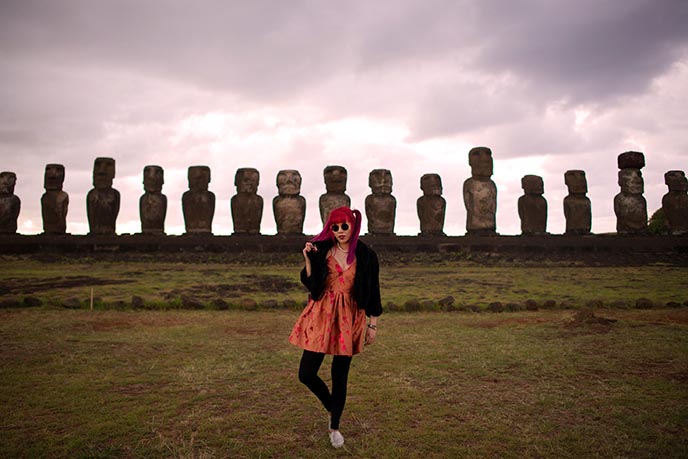
Dream. Come. True. (And the perfect new Facebook cover / banner photo!)
I still can’t believe I got to see Easter Island… it feels like a lucid dream. LATAM Airlines, the only airline that flies here, made this extraordinary trip possible.

On the second day of my journey, I woke up at 5 am to catch the famous sunrise at Tongariki. The lovely Patricia of Easter Island Travel picked us up from our hotel Hangaroa, and we drove east for about 45 minutes.
When I stepped out of the car, I was in awe at the sight before me. A crescent moon glowed above the silhouette of 15 giants standing in a row — it was a vision straight out of a sci-fi movie!
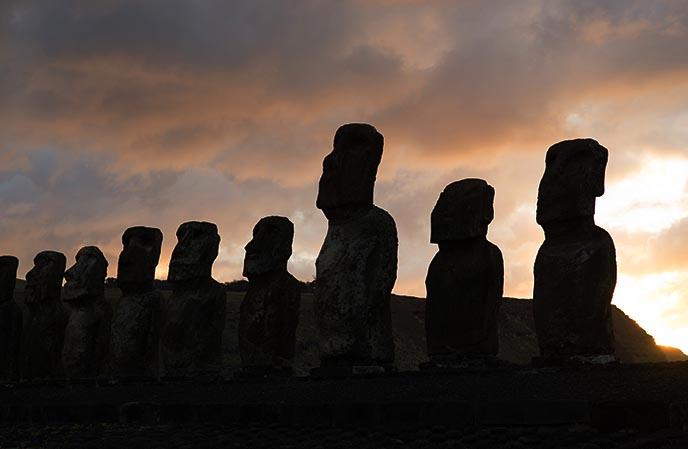
As the sun began to light up the sky, I felt like I was in front of a fleet of extraterrestrials. I can only imagine what it was like for the Dutch explorers to arrive on Easter Island in 1722, and encounter this mind-bending sight.
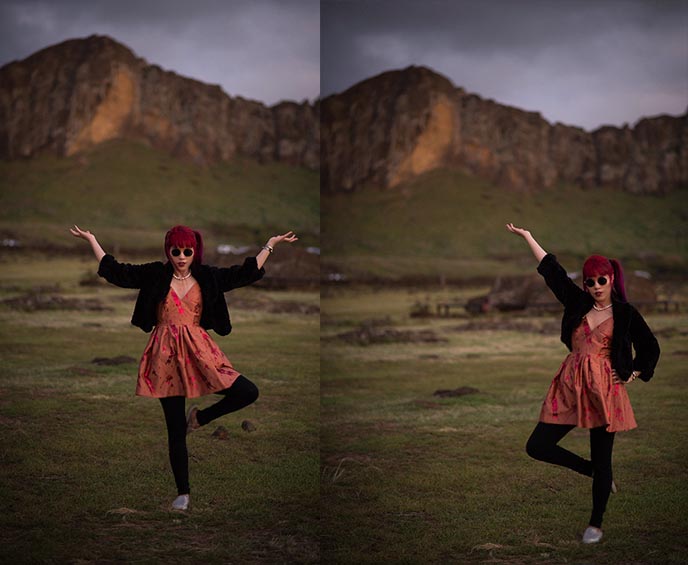
Space invader, that’s me. The landscape of Easter Island made me think of Mars.
It’s fitting that I am wearing a dress from House of Holland’s space collection. Below are more of their intergalactic designs:
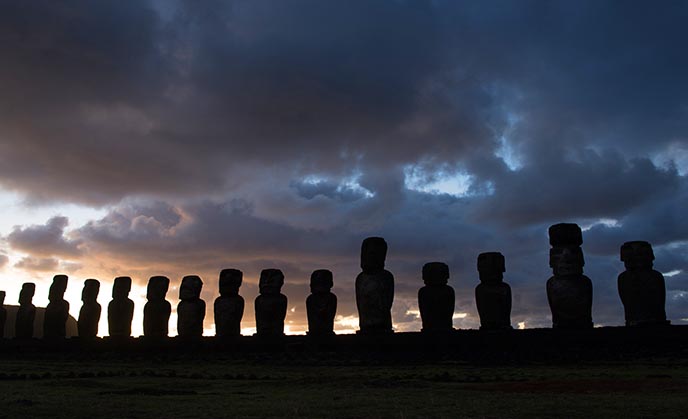
With fifteen statues in line, Tongariki is the largest “ahu” (platform) on the island.
During the island’s civil wars around the 1700s, these Godzilla-sized moai were toppled. In 1960, the ahu was also swept inland by a 9.5 earthquake (one of the largest ever recorded) and tsunami. Tongariki has since been restored, as you can see from the powerful shapes of the 15 stone men today.

Ahu Tongariki has some of the largest and most exquisite moai on the island. The largest of the bunch weighs 86 tonnes; it’s the heaviest statue ever erected by the Rapa Nui.
As you can see, only one of the moai at Tongariki still has his “pukao” (red hat or topknot). Some of the others originally had pukao as well, but their headwear was too badly damaged to be restored.
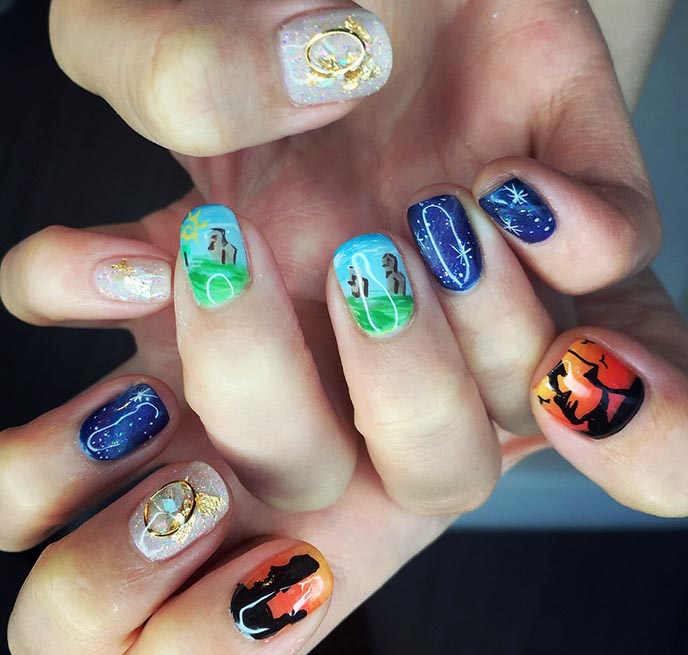
My nail art, by Keiko Matsui at Vancouver BC’s Glam Nail Studio, sums up the magic of Easter Island. She drew the stone faces and their silhouettes at dawn, as well as dark skies filled with stars.

As the sun rose, the sky burst into radiant hues of red and orange. Slowly, the rays illuminated the details of the carvings.

The moai are all unique in small ways, which gives each of them personality. Scholars believe they are homages to ancestors, and infused with “mana” or energy. No matter what you believe, these 15 elders undoubtedly radiated a feeling of power.

Alien nation. (Although Easter Island has a hot tropical climate, it is a bit chilly in the early morning, so I recommend that you wear layers).
I’m wearing metal round sunglasses by Edwardson Eyewear, and a spider brooch on my faux fur black jacket.
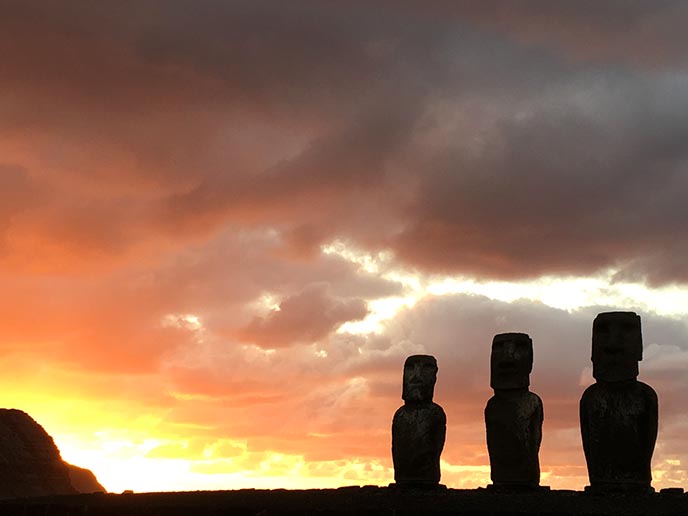
It’s easy to fantasize about aliens building these statues. However, the truth is that early humans were capable of remarkable feats of art and engineering.

Easter Island’s inhabitants knew a lot about astronomy as well. This 100-meter long platform faces sunset during the summer solstice.

On the other side of the ahu is Poike volcano, the oldest on the island. Legend tells of a battle between “the long ears” and “the short ears” taking place here.

These days, it feels like tourists are everywhere. In remote Easter Island, however, there are very few visitors.
What a joy to experience Tongariki with only about 50 other people. There was plenty of room for everyone to stand or sit (or hail the moai), and no gift stores or vendors.

When I saw this moai on thet way out, Covenant’s song lyrics came to my mind.
“Stand before the gates and watch metropolis. Empires come and go, we live forever… I stand alone.”

In the 1990s, the Japanese contributed immensely to the restoration of Tongariki. As a thank you, the people of the island sent this moai to Japan to be exhibited.

Today, this fellow is known as the “Travelling Moai” and continues to tour the world. (I think his expression is rather kawaii, don’t you?)
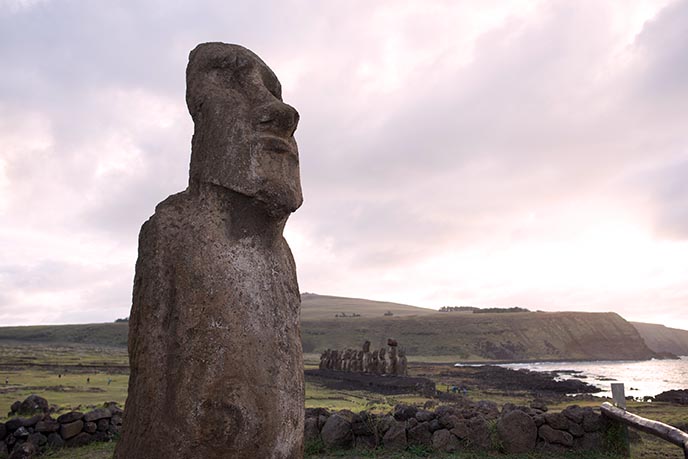
This moai was also used in the ‘walking’ experiments of Thor Heyerdahl, which researched how the inhabitants originally moved the stone figures. It’s believed that they held them upright with ropes, and shuffled them back and forth until they reached their final destinations.
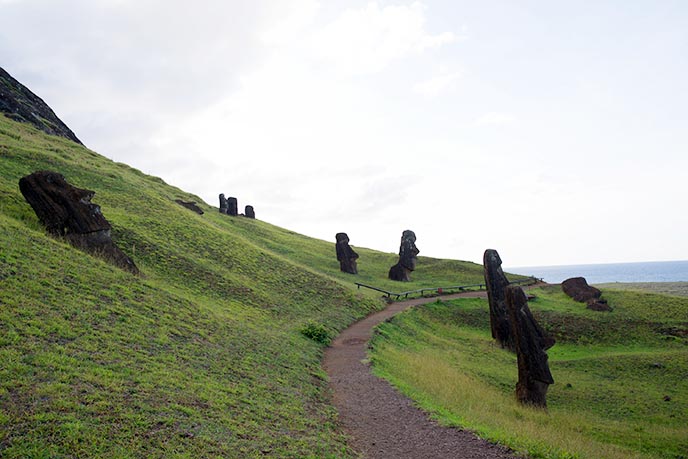
The feeling of being a “stranger in a strange land” continued at the nearby Rano Raraku. This is the stone quarry where most of the moai were carved. With monolithic heads sticking out of rolling green hills, I felt like I was inside a Super Mario video game.

Archaeologists are still making startling discoveries about the moai. Not long ago, they excavated a few of these giants… and found out that they have bodies beneath the ground! Over the years, the statues were naturally covered with eroded dirt, which left only their faces poking out from the grass.
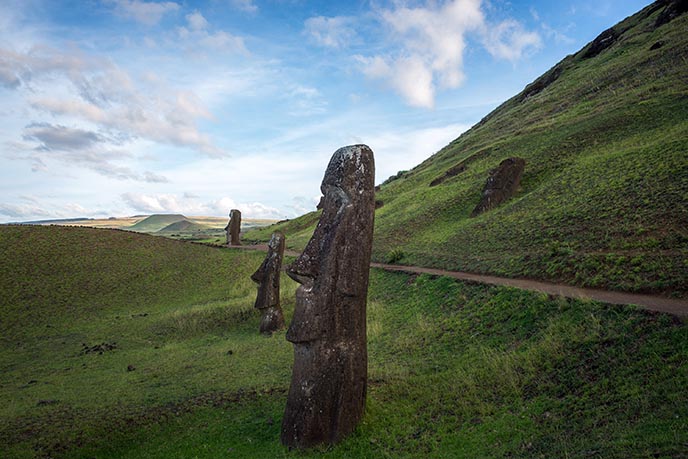
Some of the moai were half-carved or abandoned, which makes it look as if they are “sleeping” face-down. My imagination flowed as I walked around Rano Raraku. I pictured the creatures “waking up” one day, and teaching us their secrets.
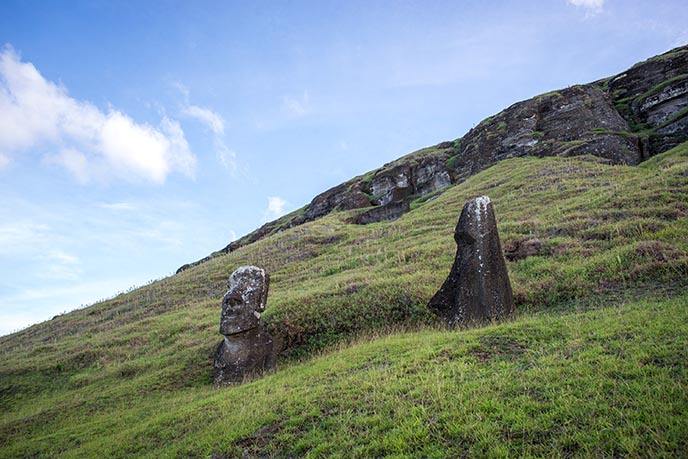
To this day, there remain so many unanswered questions about the moai. It’s extraordinary that the ancient tribes of Easter Island were able to engineer these monoliths, which have become recognizable worldwide (they even have their own emoji 🗿).
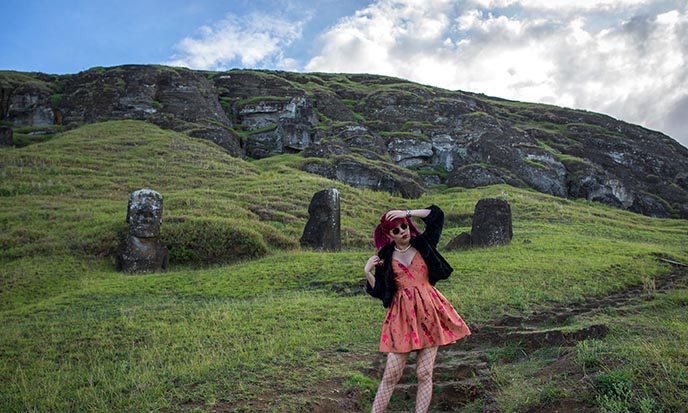
Where Do We Come From? What Are We? Where Are We Going? The moai remain tight-lipped…

As I mentioned before, you must purchase the National Park Ticket (at airport arrivals) in order to see the most famous moai, and some sites are limited to one entry only.
Visitors must stay on the paths at Rano Raraku. We saw a tourist wander off-limits towards the moai… and yelled “yo!” until a guard came horseback to tell him off!
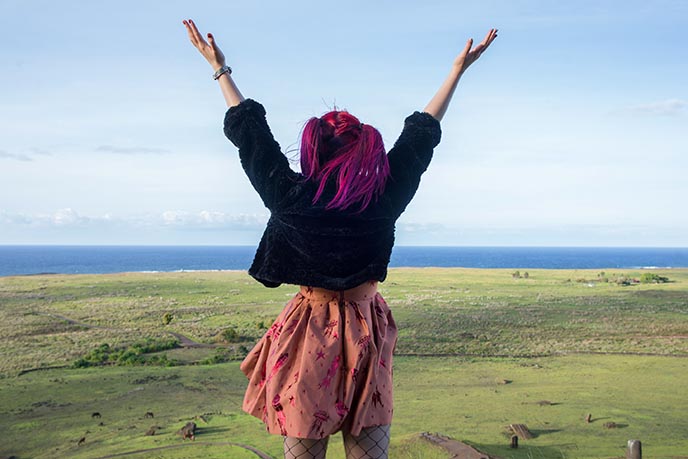
Rano Raraku is a UNESCO World Heritage Site, and these hills give a spectacular view of the surrounding ocean. There are about 400 moai resting here… I gave them a hearty Hail.

All of Easter Island’s moai were originally carved in this quarry, before being transported to various locations. Many of the moai were half-carved and abandoned, or never moved — so they remain grounded at Rano Raraku.

Here’s a big guy, in the process of emerging from stone. His profile is easy to recognize… but the artist stopped working on him for unknown reasons.

Our sweet guide, Patricia, pointed out “sleeping moai” along the roads. They fell or broke while being transported, and were abandoned as their “mana” was considered to be lost. It looks like these face-down moai are taking a nap… one day, maybe they will wake up!

With their sloped noses, pursed lips and unreadable expressions, the moai look like “chill dudes” hanging out. No wonder their replicas are often found in tiki bars.
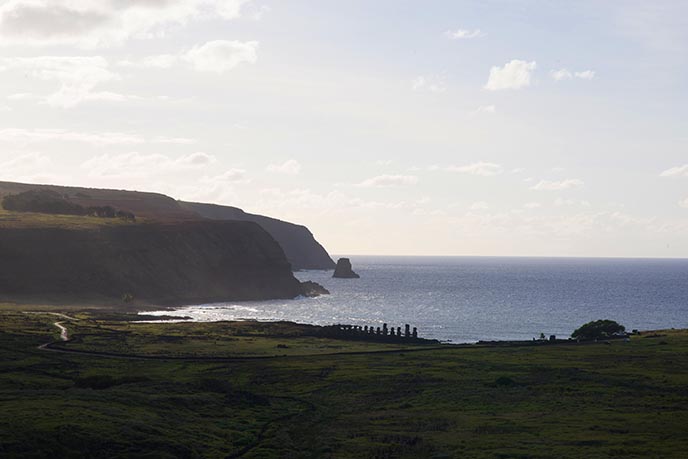
Rano Raraku is only about a five minute drive from Tongariki, so it makes sense to visit both at the same time. I recommend first seeing the sunset at Tongariki, then heading over to the quarry. Having a private driver/guide and car meant that we could be flexible, and spend as much time as we needed to take photos.
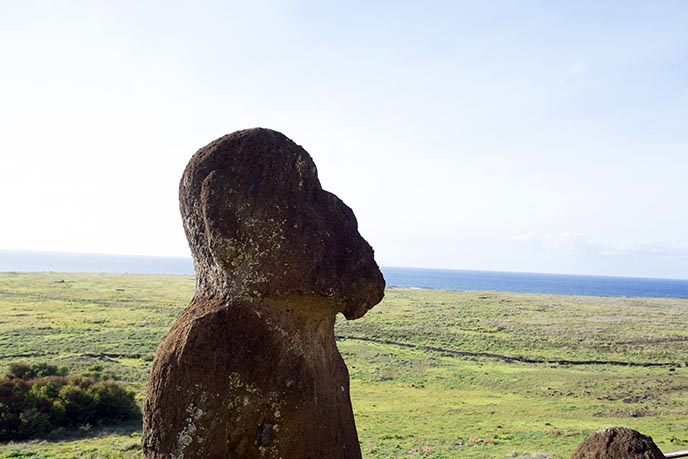
One of these moai is not like the others… Introducing “Tukuturi.” He’s carved in a different style, out of red scoria from Punu Pao. Tukutiri has a beard and unique facial features, and sits in a kneeling posture.
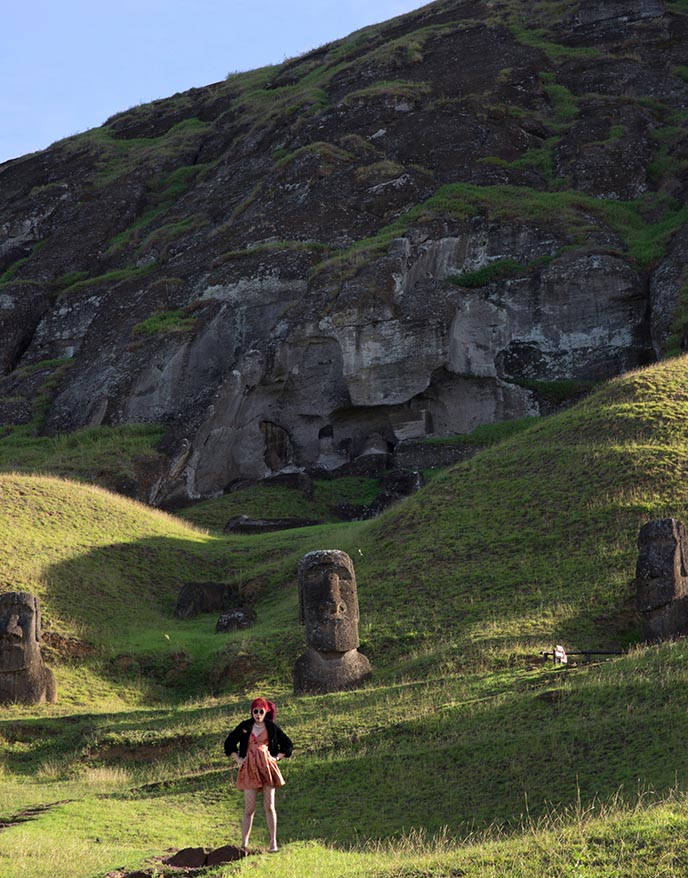
Queen of the moai, that’s me. (Isn’t the scenery of Easter Island out-of-this-world?)

The visible moai are already huge… but remember, they have bodies beneath the ground. This makes them up to three times larger!
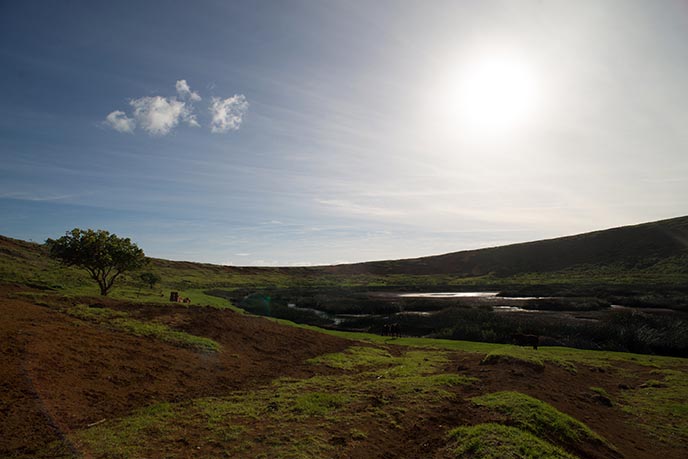
Rano Raraku is a a volcanic crater. You can take another path to see the dramatic asteroid-like indentation.

I always had a fascination with the stone-faces, and am grateful I had the chance to meet them.

Close-up on the carvings. Minimalist, monolithic mastery.
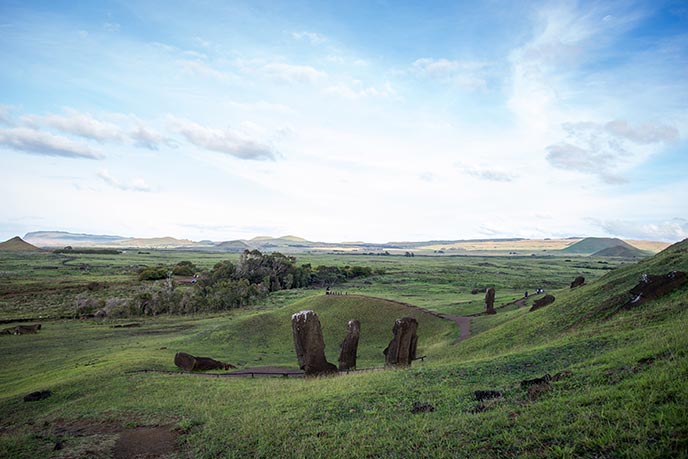
This puzzling civilization fired up my imagination. Easter Island is without doubt one of the coolest places I’ve ever been.

Details of my rockets and stars dress by House of Holland (see their space collection here). My pearl and skull necklace is Alex Streeter.

The hues of my outer space dress happened to match the sunrise. (You can see footage of the changing skies in my Instagram video.)

Although Easter Island is technically part of Chile, it feels like it belongs in another galaxy. (All photography by Joey Wong.)

Now that I had seen all the major attractions on the isle, it was time to go. We said goodbye to the horses grazing around the crater.

LATAM Airlines is a rock star for making our journey possible. Their flights were comfortable and on-time, with fantastic service from the staff.

If you’re inspired to come to Easter Island, LATAM is the way to go. I recommend booking a window seat so that you can take in these soaring views. And if you are looking for souvenirs, there are stalls at the little airport with moai-themed goods.

Visiting Easter Island felt like I had left the planet, and entered another world. If you’re fascinated by ancient cultures and mysteries, I encourage you to make this trip of a lifetime.
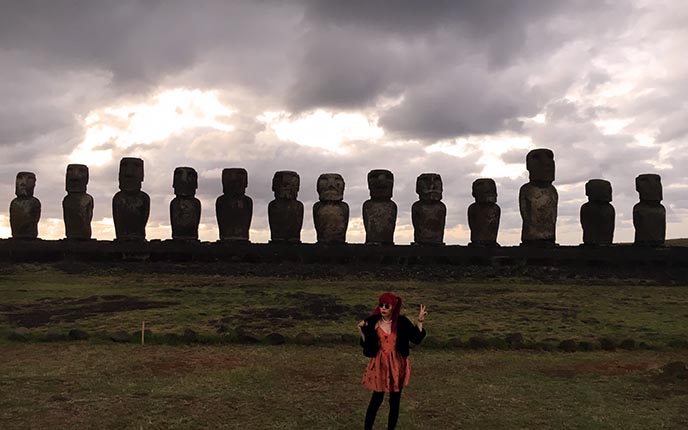
Click to see a short Instagram video of my Easter Island travels.
After seeing the stone-faced moai, I think the only thing that can top this… is a journey to outer space!

For more travel tips (including our hotel and Day 1 of our tour), see all my Easter Island articles and photos here.
Is Isla de Pascua on your bucket-list? And what do you think of the alien connection… is there anything “out there?”

Announcement: I’m heading to Japan for travel TV shoot, where I’ll be hosting and producing! I will also be traveling in Thailand and Laos with my pirates.
Since this major television program is occupying my full time, I won’t be able to do any blog updates for the next month or so. However I will update my social media regularly with Asia adventures. Please feel free to add me on @lacarmina Instagram, Twitter and Facebook for the latest updates!
As always, you can find my favorite Gothic fashion here (such as the boots, dresses and fishnets in the photo above). You can also shop my personal closet here on Depop. I’ve listed my clothing at discounted rates; email me if you’d like anything at all. “Mata ne!”
SHARE & COMMENT
Goth Alternative Buenos Aires, Argentina! Recoleta Cemetery, Palermo street art, Eva Peron restaurant, La Cabrera.

Don’t cry for me, Argentina… The truth is, I had a spectacular time in Buenos Aires!
While exploring the South American city, I channeled Eva Peron’s style in a mid-century-style white dress. However, BA also has a hipster side, as you can see from the street art of the Palermo district.

Wouldn’t you like to see the coolest parts of Buenos Aires with me? Follow along as we dine at the Eva and Juan Peron themed restaurant, scout colorful murals, and indulge in steak and gelato.
(My ivory sweetheart dress is from Unique Vintage. Click the pics below for more of their gorgeous styles:)

And of course, this ghostly Goth paid a visit to Recoleta Cemetery — thanks to everyone who recommended the graveyard to me. Read on for Argentinian tales of the dead…. (All photography by Joey Wong.)

Buenos Aires is a beautiful city, with a European feeling: picture wide, tree-lined avenues and stately architecture. You can tell I was delighted to come to Argentina for the first time thanks to LATAM Airlines, which has many international flights to EZE (Ezeiza International Airport).
I’m wearing my new Alexander McQueen / McQ sunglasses from Sunglasses Shop. Love the tortoiseshell pattern on these chunky frames, which have a vintage feel that matches my outfit. If you’re looking for fabulous summer shades, Sunglasses Shop has tons of authentic, luxury glasses available at low prices on their site.

Buenos Aires is divided into various “barrios” or neighborhoods. One of the hippest barrios is Palermo, which consists of several sections: Hollywood, Soho and Viejo.
Spend time walking around Palermo, and you’ll run into cute boutiques, independent fashion, coffee shops, boutique hotels, bars… and lots of vibrant urban art.

Palermo’s rainbow backdrops were the perfect place to shoot outfit photos. I’m wearing this Unique Vintage 1950s champagne ivory swing dress, called the “Carole.” Inspired by 1950s style, this long champagne frock has an ivory lace overlay, and boned sweetheart bodice with spaghetti straps — and even side pockets!
Here’s another similar Unique Vintage white dress. Plus more styles from this retro-fashion brand below:

Argentina was once a wealthy Spanish colony, until its emancipation during the War of Independence (1810-18). Today, Buenos Aires remains a thriving cosmopolitan capital, nicknamed the “Paris of South America” for its world-class fashion, art and architecture.
(I spent the whole day walking around, so I paired my outfit with sparkly slip-on shoes.)

Buenos Aires is one of the most developed and easy-to-navigate cities in South America. Travellers love to come here to enjoy life to the fullest: tango dancing, leisurely meals, walks through elegant neighborhoods, and lots of red wine.

Close-up on my choker necklace by Reykjavik‘s Aurum by Guðbjörg. This Asterias design is inspired by the waves and natural forms of Iceland’s landscapes. I’m all about eye-catching jewelry that reminds me of my travels, so this is a personal favorite.

I paired my outfit with a headband and scarf from Tokyo, Japan (where I’ll be heading back soon). Always trying to be one of the birds and flying away…

A curtsy in front of one of my favorite murals, an eclectic collage by BA Paste Up.
The creative Palermo area is well worth a visit, for a peek at the youth / alt subcultures of Buenos Aires.

Now, for a darker destination… La Recoleta Cemetery, home to dramatic Gothic tombs. Don’t you love the Egyptian-looking one above?
Located in Buenos Aires’ Recoleta district, this famous graveyard is the final resting place of many notables, including Eva Perón, several presidents of Argentina, and Nobel Prize winners.
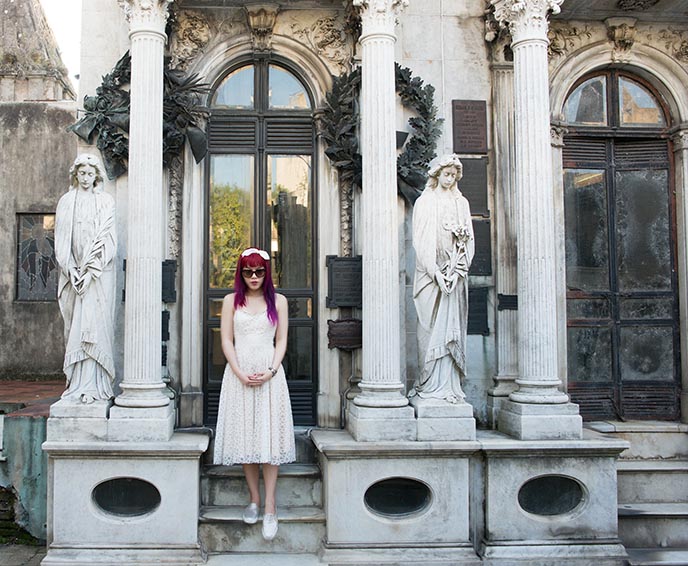
‘The woman in white” fit right in with these aristocratic mausoleums arranged in rows.
From these images, you can tell why Recoleta is considered one of the world’s most beautiful cemeteries.

Established in 1822, La Recoleta graveyard covers 14 acres. Many wealthy residents were buried here; their families put up elaborate marble mausoleums to “keep up with the Jones.” The architectural styles range (Art Deco, Art Nouveau, Baroque, Neo-Gothic), and the graves mostly are well-maintained.

These despairing angels, throwing themselves on the door of the dead… beautifully carved, and so Goth!

Arr, looks like a pirate be buried here. I was curious about these skulls and crossbones from 1875… but dead men tell no tales.

We arrived at Recoleta Cemetery as the sun was setting: the perfect golden hour for photos. Not long after, the custodian rang the bell to make sure everyone left before sundown… lest they be drained of blood by vampires, or something like that.
(Love how the top lace layer of my Unique Vintage dress captured the light. More designs from this retro vintage inspired designer below.)

We let the undead rest in peace, and walked on to our next destination…

… El Ateneo Grand Splendid bookstore. The name says it all: this is an exquisite 100-year-old theater that was converted into a book shop.
(On the right, do you see me up on the balcony, doing my best impression of Eva Peron giving her “final speech” to the people?)

Located in Barrio Norte, El Ateneo preserves the pomp of the former Grand Splendid Theater, which opened in 1919. The bookstore retains the gilded theatre booths, red velvet curtains over the stage, and Italian ceiling frescoes.

This venue has been at the heart of Buenos Aires’ entertainment industry over the years. In the earliest days, tango singers made recordings inside. The theatre became a cinema in the 1920s, and hosted the first “sound films” of Argentina. Today, the space is a wonderland for book lovers, and maintains the spirit of the Teatro Gran Splendid.

Buenos Aires’ food scene is also world-renown. The local specialty is, of course, Argentinian beef. Try the traditional “asado” or barbecue, or go to a “parrilla” (steakhouse) where the meat is cooked on metal grills by the same name.

I researched the best “parrillas” in Buenos Aires, and noticed that La Cabrera steakhouse had rave reviews. I arrived at the bright, rustic courtyard-style space in Palermo Viejo — and was greeted by the chef himself, Gastón Riveira!
Chef Riveira opened La Cabrera in 2003. Today, he’s celebrated for his outstanding menu that offers over 25 highest-quality cuts of beef, sides and Argentine wines. He’s now also a cookbook author and has three restaurant locations in BA, as well as in Paraguay, the Philippines, Dubai, Brazil and Peru.
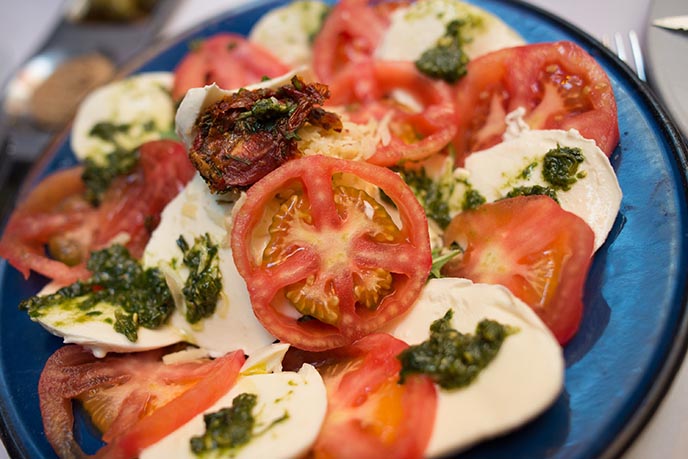
Our attentive server was great at explaining the various specials and cuts, and showed us a photo of the various “done-ness” to choose from. If you’re not big on meat, don’t worry — La Cabrera pays close attention to all its dishes, including vegetarian options and sides. We received a generous portion of caprese salad, with the freshest pesto, tomatoes and buffala. With a glass of local Malbec (red wine), it was the perfect start.

Here come the big guns. Tender short-ribs, and a spectacular Wagyu steak — one of the best in my lifetime so far. Many steakhouses overlook the side dishes, but not La Cabrera. The chimichurri green sauce, mustard and garlic dips, pureed squash, and mashed potatoes were total umami.
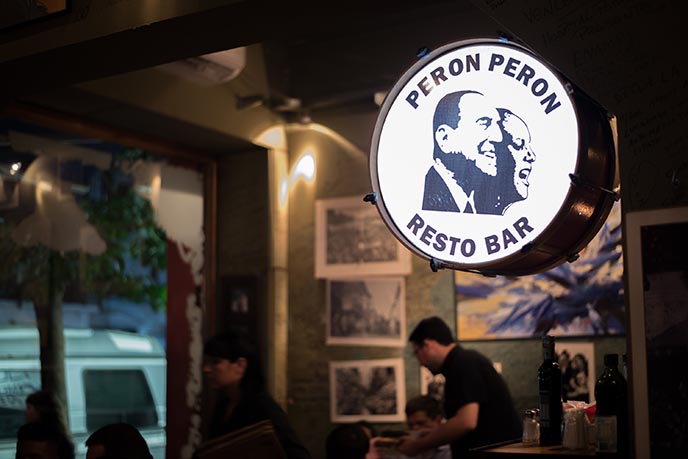
For another “only in Argentina” meal, make a reservation at Perón Perón resto bar (Address: Ángel Justiniano Carranza 2225, 1425 CABA, Argentina). This theme restaurant is dedicated to Juan Peron, President of Argentina three times in the mid-20th century, and his iconic wife Eva Peron — aka Evita.
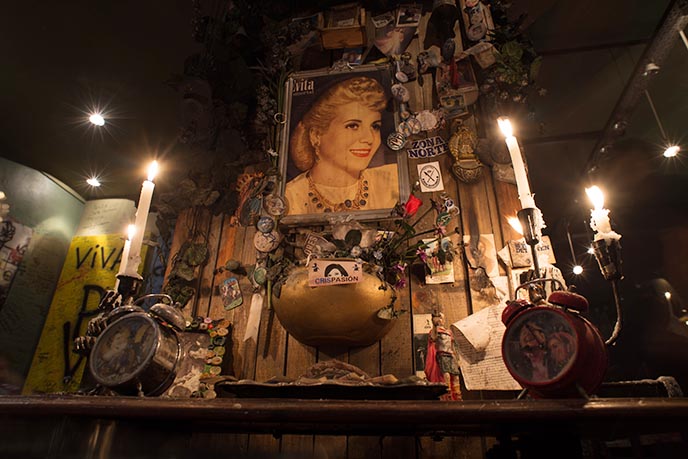
Try to reserve the special table, right in front of this shrine to Eva Peron! She smiled above us as we ate, surrounded by photos, candles, and vintage memorabilia.
Eva Duarte rose from poverty to fame as a stage, radio, and film actress. She married Colonel Juan Perón and became the First Lady of Argentina upon his presidency. “Evita” is beloved for her dedication to labor rights and women’s suffrage, and a foundation that helped low-income and working class Argentines. When she died from cervical cancer at age 33, Eva Perón received the title of “Spiritual Leader of the Nation” by the Argentine Congress.

The menu at Peron Peron captures the spirit of their politics, with cocktails named “We are the resistance” and “Nestor is alive” — a delicious mix of cynar, ginger syrup, angostura, fresh lemon juice and mint. (The name is a reference to Néstor Carlos Kirchner, President of Argentina in the 2000s with a Peronist ideology.)
We were feeling a bit “beefed out,” so we began with my beloved sardines, flavored with paprika and vegetables.
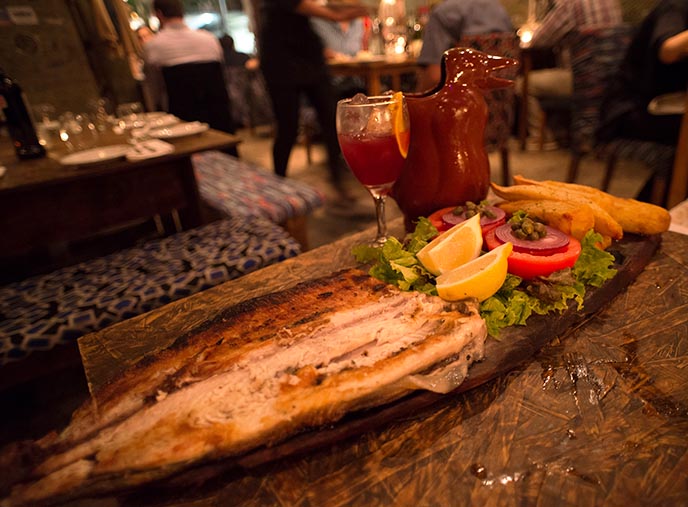
For the main, we had a large and juicy portion of South American pacu, a freshwater fish related to the piranha. This rustic “meal of the people” paired perfectly with red Sangria (ginger syrup, fruit and Justicialist Party wine). The drink came in a pinguino jar, which was popular among the working class in the 1920s and 30s, and inspired by the penguins of the Patagonia region.
The menu stated: General Peron said it loud and clear… “When one is hungry, no bread is stale.” At Peron Peron, however, everything was a fresh as could be.
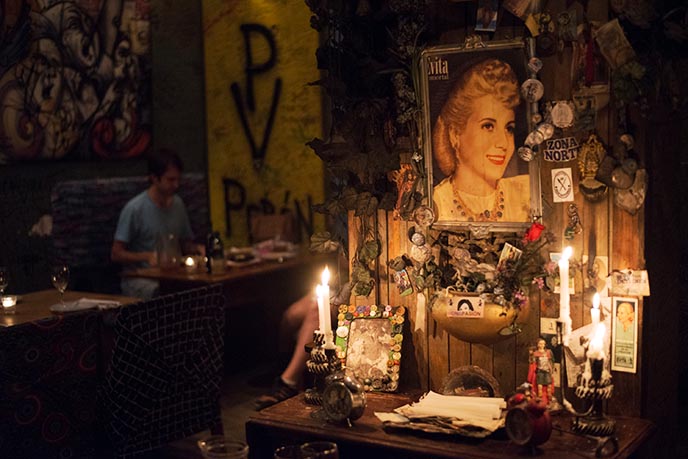
The restaurant isn’t a gimmicky tourist attraction — it’s a loving tribute to the Perons. All around, you can see paintings and photos: old headshots of Evita from her acting days, the couple waving from a parade car after winning the election.
Many groups of “Peronist” locals gather here to dine and chat politics. Twice a night, the restaurant broadcasts the “Marcha Peronista” song. Their supporters stand up, wave napkins around their heads, bang the tables and sing loudly to the refrain “Viva Peron!”

Stuffed and satisfied, I was glad to return to my Wimdu apartment rental. I had a superb stay in this local flat, which let me live like “one of the people” in Buenos Aires.
It was a breeze to book this apartment with Wimdu: the search engine pulled up available listings with photos and reviews, and this cute one caught my eye. I messaged with the owner, and easily picked up and returned the keys to the concierge at the lobby. I’m very glad I stayed here, as it was inexpensive and located centrally in San Telmo (I’ll show you stories from this district in the next post).

Let’s end on a sweet note, and a bonus food tip. Eat all the gelato, while you’re in Buenos Aires! The city is famous for its ice cream, which goes down especially well after a day of strolling under the sun. Locals told me one of the best gelaterias is Rapanui in Recoleta / Barrio Norte, and they were correct. I ordered a heavenly double scoop, and picked up dark chocolate to bring home as well.
Smile, there’s more to come soon from Argentina! Gracias LATAM Airlines for the flights here, and to Blacklane Limousines for the efficient airport transfers in a sleek black Mercedes SUV.
Have you visited the city of Evita? What are your impressions of Buenos Aires so far?


 LA CARMINA
LA CARMINA






